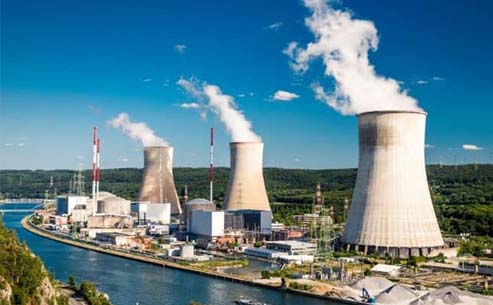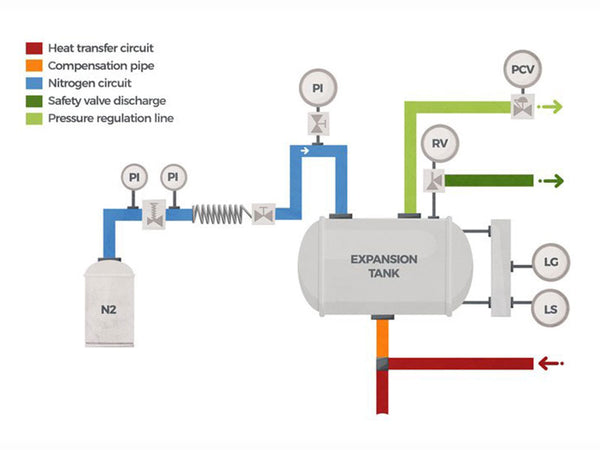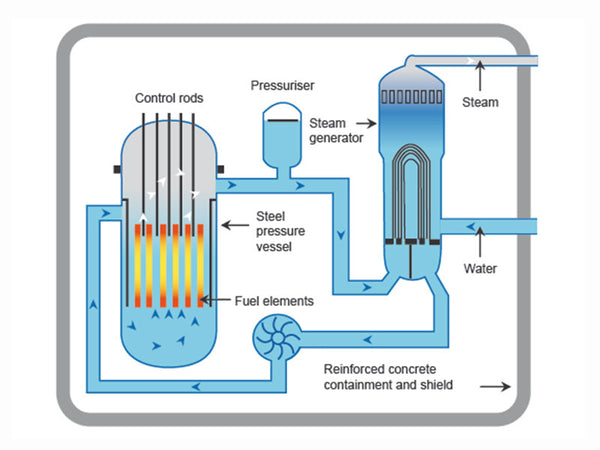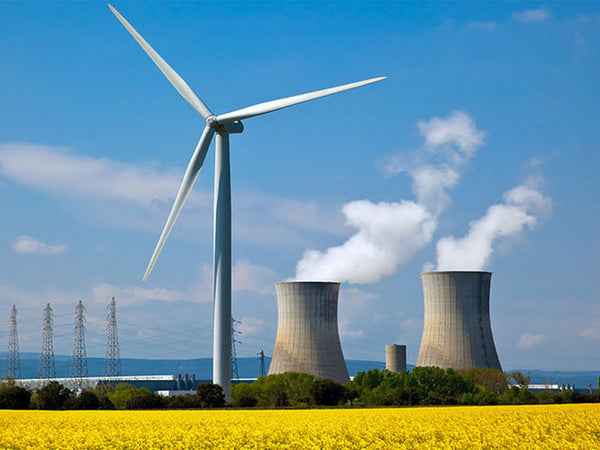
main content:
- 1 Atomic boiler nuclear reactor
- 2 An important part of a nuclear power plant: pressurized water reactor
- 3Nuclear power is clean energy
1 Atomic boiler nuclear reactor

How is nuclear energy used to generate electricity and become electricity?
Thermal power plants use boilers to burn coal and other fossil fuels to produce steam to derive steam to drive steam turbines and drive generators to generate electricity. This is familiar to everyone. Nuclear power plants also produce steam to drive steam turbines and generators to generate electricity. In other words, in terms of power generation equipment, nuclear power plants are exactly the same as conventional thermal power plants. The location where the steam turbines and generators of nuclear power plants are located is called "conventional islands." But the heat source for producing steam in nuclear power plants is not a boiler, but a "nuclear reactor." Therefore, a nuclear reactor is called an "atomic boiler" and its location is called a "nuclear island."
Nuclear reactor is a device that realizes large-scale controllable nuclear fission chain reaction, referred to as "reactor", it is the key equipment for mankind to obtain nuclear energy. How can the reactor achieve a controlled nuclear fission chain reaction? It turns out that each uranium-235 nuclear fission will produce 2~3 new neutrons. If only one neutron is allowed to participate in the fission of the next generation, and each generation is controlled in this way, the fission process can maintain a constant number. In this way, the chain reaction can proceed automatically and continuously produce neutrons and energy without being overly intense. In addition to being absorbed by the impurities in the core, the excess neutrons must also be controlled by special neutron-absorbing materials to absorb the excess neutrons.
Controlled Chain Fission Reaction Diagram

The reactor of a nuclear power plant is a kind of "power reactor", and its basic components are the core, coolant, moderator and reflector.
Pressure shell and primary circuit system diagram

The core is composed of nuclear fuel assemblies and control rods. The nuclear fuel assembly is a small cylindrical fuel pellet made of chemically inactive uranium dioxide (UO2), which is put into a zirconium alloy tube and sealed and welded to form a slender fuel element rod, and then the element rods are arranged. In rows and columns, fixed with positioning grid. In the "pressurized water reactor" of a 900,000-kilowatt generator set, the core is generally loaded with 157 fuel assemblies, with a total of about 80 tons of UO2. The first charge is divided into three concentrations, namely 1.8%~2.1% uranium-235, 2.4%~2.6%, 2.9%~3.2%, each accounting for 1/3 of the material. About 1/3 of the fuel is replaced every year, and the uranium-235 concentration is 3.1%~3.4%. In order for the reactor to achieve a self-sustaining chain fission reaction (called a critical reaction, that is, to ensure that a certain number of neutrons react during the reaction), there must be a minimum nuclear fuel load, called the "critical load". In the critical reaction, the "reactivity" of the core is set to 1. In order to ensure the service life of the reactor, the loading capacity mentioned above is actually greater than the critical loading capacity, which makes the reactor core in a supercritical state when it starts to operate, with a reactivity greater than 1. The part greater than 1 is called "excess reactivity", generally 15% to 20%. When operating in this state, there are too many neutrons and the reaction will be too violent. In order for the reactor to work normally, it is necessary to add a strong neutron absorber to eat up this part of the excess reactivity, and with the consumption of fuel, this part of the reactivity is gradually released to ensure that the reactor is constantly in a critical state, "control The "stick" is the device that plays this role.
Control rods, also known as safety rods, are made of materials that can absorb neutrons (such as cadmium, boron, etc.) to control the number of neutrons in the reactor. Specifically, it has two functions: one is to absorb the excess neutrons in the self-sustained chain reaction and the other is to absorb the excess neutrons generated by the supercritical load, that is, to eat the "excess reactivity". In this way, the control rod can control the speed of the reactor core chain reaction and maintain the reaction at a predetermined level (such as a critical state) to realize the opening, shutting down and adjusting the size of the reactor power.
Coolant, also known as heat carrier. In order to conduct the heat of the core chain reaction. The reactor must have coolant. Commonly used coolants include water, heavy water, carbon dioxide, helium, and liquid sodium.
Moderator, used to slow down neutrons. Although the nuclear fuel uranium-235 in the core is enriched, it only accounts for about 3% of the core material. The rest are uranium-238 isotopes that only absorb neutrons and do not produce fission. In contrast, uranium- 235 is difficult to compete with neutrons. In this way, the chain reaction is difficult to proceed. Therefore, according to the characteristics of uranium-235, "preferential" conditions for obtaining neutrons must be imposed. Uranium-235 has the characteristics of easier capture of slow neutrons, so materials that can slow down the neutrons (fast neutrons) produced by fission can be placed in the reactor to facilitate the preferential capture of slow neutrons by uranium-235 and ensure a chain reaction The progress. This material is called a "moderator". Generally used as moderators are water, heavy water, graphite and so on.
The reflective layer, that is, the neutron reflective layer, is arranged around the active area of the nuclear fuel element. It can reflect back the neutrons that escaped from the active area, thereby reducing the leakage of neutrons, and the purpose is to ensure the stable progress of the chain reaction. As the material of the reflective layer, there are water, heavy water, graphite, beryllium and the like.
It can be seen from the reactor structure of nuclear power plants that different types of nuclear reactors can be designed due to different coolant and moderator materials. There are currently three types of nuclear power plant reactors in the world that are relatively mature, namely light water reactors (also partial pressure water reactors and boiling water reactors), graphite gas-cooled reactors and heavy water reactors, and pressurized water reactors are the most widely used.
Table: Types of nuclear reactors in the world
|
Reactor type |
In progress |
Under construction |
||
|
|
quantity |
capacity/GWe |
quantity |
capacity/GWe |
|
Pressurized water nuclear reactor(PWR) |
267 |
241.2 |
11 |
10.4 |
|
Boiling water reactor(BWR) |
92 |
82.0 |
4 |
5.0 |
|
Canadian Heavy Water Uranium Reactor(PHWR) |
40 |
20.5 |
7 |
2.6 |
|
Air-cooled reactor(GCR) |
22 |
10.7 |
0 |
0.0 |
|
Light water graphite reactor(LWGR) |
16 |
11.4 |
1 |
0.9 |
|
Fast breeder reactor(FBR) |
3 |
1.0 |
1 |
0.5 |
|
total |
440 |
366.8 |
24 |
19.4 |
2 An important part of a nuclear power plant: pressurized water reactor

The pressurized water reactor uses ordinary water (light water) as a coolant and a moderator, and the entire reactor core is placed in a pressure vessel (pressure shell). Water flows through the gaps in it. At this time, the water pressure is about 150 The water temperature reaches 300℃ without boiling, and the PWR is named after it.
The biggest feature of the PWR is that it has two separate circuits, namely the main circuit of the nuclear island (also known as the primary circuit) and the secondary circuit of the conventional island. The water in the two circuits is not in direct contact, but heat exchange is carried out in the steam generator. The heat of the primary circuit is transferred to the secondary circuit and steam is generated. The steam is led out to drive the steam turbine to generate electricity. In this way, even if the core components are damaged or leaked, the radioactive materials will only circulate in the primary circuit and will not diffuse into the secondary circuit. In contrast, boiling water reactors have obvious disadvantages. Boiling water reactors also use light water as a coolant and moderator, but there is no distinction between primary and secondary circuits. Water will boil in the reactor to produce steam, which is directly led out to drive steam turbines to generate electricity. In this way, it is easy to spread radioactive materials from the nuclear island in the event of a nuclear leak.
| Tips: Types of nuclear power plant reactors Nuclear power plant reactors are a type of "power reactors" that provide power. According to the type of nuclear fuel, coolant, moderator and neutron energy used, it can be divided into four types. 1. Light water reactor. Use ordinary water (light water) as the coolant and moderator. Light water reactors are divided into two types: boiling water reactors and pressurized water reactors. Light water reactors are currently the most used in nuclear power plants in the world, accounting for about 85%. 2. Heavy water reactor. Use "heavy water" (H3O) as the coolant and also as the moderator. Because heavy water has good neutron slowing performance and the probability of absorbing neutrons is small, heavy water reactors can use natural uranium as fuel without enrichment. Heavy water reactors account for about 10% of nuclear power plants. 3. Air-cooled reactor. Use gases such as CO2 and helium (He) as the coolant, and graphite as the moderator. Currently, helium is mostly used as the coolant to obtain a high temperature heat source of 800°C. Gas-cooled reactors account for 2% to 3% of nuclear power plants. 4. Fast breeder reactor, referred to as "fast reactor". This kind of reactor does not need a moderator, directly uses fast neutrons with larger energy, and uses natural uranium as fuel. The vast majority of natural uranium is uranium-238, which absorbs fast neutrons in the reactor's reaction to become plutonium-239. Plutonium-239 is also a nuclear fuel and can produce chain reactions under the action of fast neutrons. The heat transfer problem of fast reactors is particularly prominent, and liquid metal sodium (Na) is usually used as a coolant. At present, the proportion of fast reactor nuclear power plants in various reactor types is very small, less than 1%. |
Because the pressurized water reactor uses light water as the coolant and moderator, the reactor is small in size, short in construction period, and low in cost. In addition, the primary circuit and secondary circuit system are separated, operation and maintenance are convenient, and the radioactive "three wastes" that need to be processed are less. The safest and most economical type of reactor. Therefore, pressurized water reactors dominate nuclear power plants. At present, pressurized water reactors provide more than half of the world's total nuclear power generation and are used on more than 300 nuclear-powered ships.
Heavy water reactors and gas-cooled reactors have their own characteristics, but they still account for a small number of nuclear power plants. Heavy water reactors account for less than 10%, and gas-cooled reactors only account for 2% to 3%.
3 Nuclear power is clean energy

The most important application of nuclear energy is power generation, which provides energy in the form of electricity. The process of nuclear power generation is also clean production, which poses no harm to the environment and ecology. Compared with fossil energy, the impact on the environment and ecology is much smaller.
Fossil energy provides energy in the form of chemical energy. After the carbon in the fuel is burned, it will eventually generate carbon dioxide and be discharged to the environment. It is the most important greenhouse gas" and is the chief culprit of global warming. In addition to CO2, due to Fossil fuels, especially coal and petroleum, contain impurities such as sulfur, which generate harmful compounds such as sulfur dioxide and soot when burned, which pollutes the environment and harms the ecology. A coal-fired power plant with an installed capacity of 2 million kilowatts like the Daya Bay Nuclear Power Plant consumes coal every year About 6 million tons, about 13 million tons of CO2, about 100,000 tons of SO2, smoke, nitrous oxide, carbon oxide, benzopyrene and other harmful substances, and more than 1 million tons of ash will accumulate, including toxic heavy metals. 1000 tons. So many environmental pollutants produced by fossil fuels do not exist for nuclear power plants. For power plants with the same power, the quality of nuclear fuel parts is one tens of thousands of that of coal power plants. Most nuclear power plants are located in Qingshan The coastal area with green water quietly delivers clean electricity, and the unparalleled clean environment with coal power plants can be used as tourist attractions.
The Mihama Nuclear Power Plant in Japan is about 50 kilometers away from Kyoto. People are swimming on the beach near the nuclear power plant.

Is there anything to compare? That is the problem of radioactive pollution that people are most concerned about. Nuclear power plants do produce radioactive waste. A nuclear power plant with an installed capacity of 2 million kilowatts will generate nearly 60 tons of high-level (ie high-level radioactive) “spent fuel”, about 600 tons of intermediate level waste, and about 1,000 tons of waste per year. Low-level radioactive waste, which is the main hazardous waste of nuclear power plants. However, these wastes are not randomly dumped and discharged like ordinary factories. It has strict treatment procedures and management systems. The first is the centralized recycling of high-level radioactive waste "spent fuel", which reduces the high-level radioactive waste to 1/3, and then it is deeply hidden in the waste repository for permanent storage. For medium and low-level radioactive waste, including evaporation residual concentrated liquid residue, filter mud, waste filter element, ion exchange resin, scrap equipment and tools and labor protection supplies in the production process, it can be compressed and incinerated to reduce volume, while mud and residue , Waste resin, etc., are mixed with cement, asphalt or plastic, sealed in metal or cement barrels for solidification, and stored together in the permanent waste warehouse. Radioactive liquids, including factory waste water and washing water, must be collected and treated separately, such as storage decay, evaporation and concentration, ion exchange, electrodialysis, reverse osmosis, etc., until they are qualified, and then recycled and partially discharged. The exhaust gas of nuclear power plants mainly comes from the ventilation and exhaust of some technological processes and factories. Before discharge, it has to go through multiple filtering procedures to remove radioactive materials, and most of the radioactive dust is filtered out, and then discharged into the chimney. There are also radioactive gaseous substances (such as iodine-131, etc.), which are specially equipped with adsorbers to purify them. For some gases with strong radioactivity in the process, they are compressed and stored in the "decay box" for a period of time to reduce their radiation intensity, and then be filtered before being discharged. The chimney of a nuclear power plant is always smoke-free, and is actually a ventilating tube.
Because nuclear power plants have very strict treatment and disposal of the "three wastes", the radioactive substances discharged into the environment are very low, even much less than that of coal power plants. There are also radioactive minerals such as uranium, thorium, radium, potassium, etc., which are mixed in various amounts, which are not noticed and valued by people. According to estimates, in most cases, coal power plants of the same scale release to the environment several times to tens of times, or even hundreds of times, more radioactive materials than nuclear power plants.
Under normal circumstances, the annual radiation dose of radioactive materials released by nuclear power plants by residents near nuclear power plants is only 1/3 of that of thermal power plants of the same scale, which is equivalent to 1/2 of the annual TV radiation dose, which is much lower than international radiation protection. The standards set by the committee. The impact of nuclear power on public health is much smaller than that of coal power plants. The environmental impact of nuclear power plants and coal power plants can be referred to the following table.
Table: Comparison of environmental impact of nuclear power plants with electric power of 1 million kilowatts and coal power plants
|
Power plant category |
The radiation dose received by residents |
Sulfur dioxide emissions tons/year |
Nitrogen oxide emissions tons/year |
Tons of soot and special substances/year |
|
Coal-fired power plant |
0.048 |
46000~127500 |
26250~30000 |
3500 |
|
Pressurized water reactor nuclear power plant |
0.018 |
0 |
0 |
0 |
















